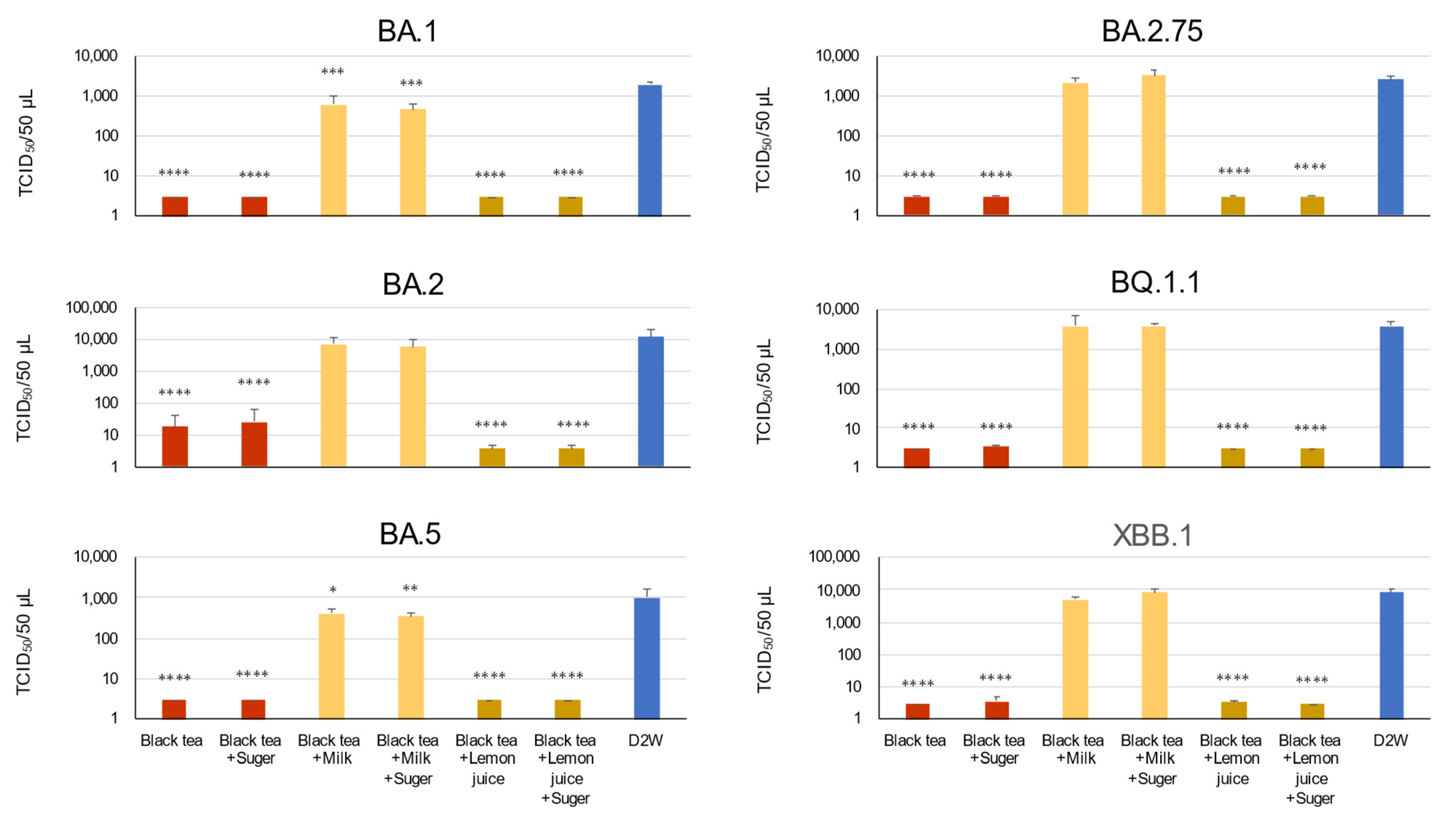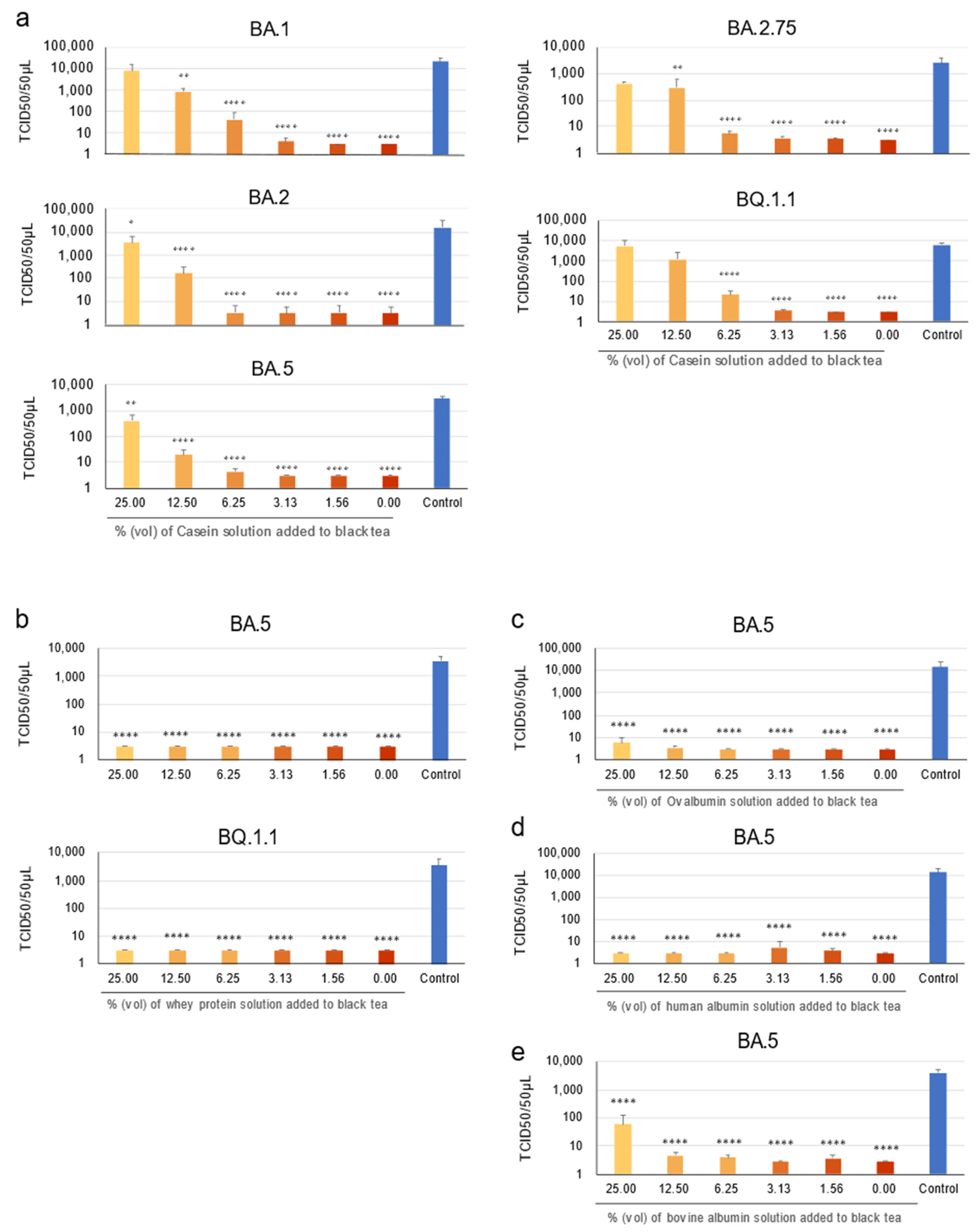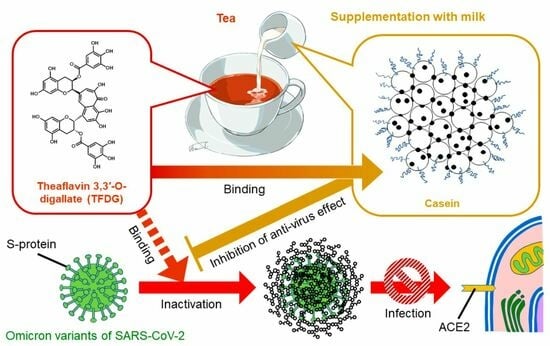Milk Casein Inhibits Effect of Black Tea Galloylated Theaflavins to Inactivate SARS-CoV-2 In Vitro
Abstract
:1. Introduction
2. Materials and Methods
2.1. Virus, Cells, and Culture Medium
2.2. Reagents
2.3. Virus Treatment and TCID50 Assay
2.4. Calculation of TCID50 Values
2.5. Measurement of Concentrations of TFs
2.6. Statistical Analysis
3. Results
3.1. Milk Prevented Inactivation of SARS-CoV-2 by Black Tea
3.2. Casein Prevented Inactivation of SARS-CoV-2 by Black Tea
3.3. Anti-Viral Activity of Black Tea Was Not Suppressed by Other Proteins. including Whey Proteins
3.4. TFs Bind to Casein
4. Discussion
5. Conclusions
Supplementary Materials
Author Contributions
Funding
Institutional Review Board Statement
Informed Consent Statement
Data Availability Statement
Acknowledgments
Conflicts of Interest
References
- Huang, N.; Perez, P.; Kato, T.; Mikami, Y.; Okuda, K.; Gilmore, R.C.; Conde, C.D.; Gasmi, B.; Stein, S.; Beach, M.; et al. SARS-CoV-2 infection of the oral cavity and saliva. Nat. Med. 2021, 27, 892–903. [Google Scholar] [CrossRef] [PubMed]
- Drozdzik, A.; Drozdzik, M. Oral Pathology in COVID-19 and SARS-CoV-2 Infection-Molecular Aspects. Int. J. Mol. Sci. 2022, 23, 1431. [Google Scholar] [CrossRef] [PubMed]
- Khan, S.; Liu, J.; Xue, M. Transmission of SARS-CoV-2, Required Developments in Research and Associated Public Health Concerns. Front. Med. 2020, 7, 310. [Google Scholar] [CrossRef] [PubMed]
- Li, Y.; Ren, B.; Peng, X.; Hu, T.; Li, J.; Gong, T.; Tang, B.; Xu, X.; Zhou, X. Saliva is a non-negligible factor in the spread of COVID-19. Mol. Oral. Microbiol. 2020, 35, 141–145. [Google Scholar] [CrossRef]
- Peng, X.; Xu, X.; Li, Y.; Cheng, L.; Zhou, X.; Ren, B. Transmission routes of 2019-nCoV and controls in dental practice. Int. J. Oral. Sci. 2020, 12, 9. [Google Scholar] [CrossRef]
- Patel, K.P.; Vunnam, S.R.; Patel, P.A.; Krill, K.L.; Korbitz, P.M.; Gallagher, J.P.; Suh, J.E.; Vunnam, R.R. Transmission of SARS-CoV-2: An update of current literature. Eur. J. Clin. Microbiol. Infect. Dis. 2020, 39, 2005–2011. [Google Scholar] [CrossRef]
- Wang, C.C.; Prather, K.A.; Sznitman, J.; Jimenez, J.L.; Lakdawala, S.S.; Tufekci, Z.; Marr, L.C. Airborne transmission of respiratory viruses. Science 2021, 373, abd9149. [Google Scholar] [CrossRef]
- Xu, R.; Cui, B.; Duan, X.; Zhang, P.; Zhou, X.; Yuan, Q. Saliva: Potential diagnostic value and transmission of 2019-nCoV. Int. J. Oral. Sci. 2020, 12, 11. [Google Scholar] [CrossRef]
- Shamsoddin, E. Saliva: A diagnostic option and a transmission route for 2019-nCoV. Evid. Based Dent. 2020, 21, 68–70. [Google Scholar] [CrossRef]
- Tang, J.W.; Marr, L.C.; Tellier, R.; Dancer, S.J. Airborne transmission of respiratory viruses including severe acute respiratory syndrome coronavirus 2. Curr. Opin. Pulm. Med. 2023, 29, 191–196. [Google Scholar] [CrossRef]
- Ohgitani, E.; Shin-Ya, M.; Ichitani, M.; Kobayashi, M.; Takihara, T.; Kawamoto, M.; Kinugasa, H.; Mazda, O. Significant Inactivation of SARS-CoV-2 In Vitro by a Green Tea Catechin, a Catechin-Derivative, and Black Tea Galloylated Theaflavins. Molecules 2021, 26, 3572. [Google Scholar] [CrossRef] [PubMed]
- Ohgitani, E.; Shin-Ya, M.; Ichitani, M.; Kobayashi, M.; Takihara, T.; Kawamoto, M.; Kinugasa, H.; Mazda, O. Rapid Inactivation In Vitro of SARS-CoV-2 in Saliva by Black Tea and Green Tea. Pathogens 2021, 10, 721. [Google Scholar] [CrossRef] [PubMed]
- Henning, S.M.; Fajardo-Lira, C.; Lee, H.W.; Youssefian, A.A.; Go, V.L.; Heber, D. Catechin content of 18 teas and a green tea extract supplement correlates with the antioxidant capacity. Nutr. Cancer 2003, 45, 226–235. [Google Scholar] [CrossRef] [PubMed]
- Matsuyama, S.; Nao, N.; Shirato, K.; Kawase, M.; Saito, S.; Takayama, I.; Nagata, N.; Sekizuka, T.; Katoh, H.; Kato, F.; et al. Enhanced isolation of SARS-CoV-2 by TMPRSS2-expressing cells. Proc. Natl. Acad. Sci. USA 2020, 117, 7001–7003. [Google Scholar] [CrossRef]
- Li, M.; Yu, H.; Chen, J.; Abdlla, R.; Liu, A.; Song, W.; Zhang, J.; Zhang, X.; Yue, X.; Li, Q. Novel insights into whey protein differences between donkey and bovine milk. Food Chem. 2021, 365, 130397. [Google Scholar] [CrossRef]
- Cervone, F.; Diaz Brito, J.; Di Prisco, G.; Garofano, F.; Norona, L.G.; Traniello, S.; Zito, R. Simple procedures for the separation and identification of bovine milk whey proteins. Biochim. Biophys. Acta 1973, 295, 555–563. [Google Scholar] [CrossRef]
- Pezzotti, G.; Ohgitani, E.; Shin-Ya, M.; Adachi, T.; Marin, E.; Boschetto, F.; Zhu, W.; Mazda, O. Instantaneous “catch-and-kill” inactivation of SARS-CoV-2 by nitride ceramics. Clin. Transl. Med. 2020, 10, e212. [Google Scholar] [CrossRef]
- Shin-Ya, M. Submitted for publication.
- Bijl, E.; van Valenberg, H.J.; Huppertz, T.; van Hooijdonk, A.C. Protein, casein, and micellar salts in milk: Current content and historical perspectives. J. Dairy. Sci. 2013, 96, 5455–5464. [Google Scholar] [CrossRef]
- Aguie-Beghin, V.; Sausse, P.; Meudec, E.; Cheynier, V.; Douillard, R. Polyphenol-beta-casein complexes at the air/water interface and in solution: Effects of polyphenol structure. J. Agric. Food Chem. 2008, 56, 9600–9611. [Google Scholar] [CrossRef]
- Jobstl, E.; Howse, J.R.; Fairclough, J.P.; Williamson, M.P. Noncovalent cross-linking of casein by epigallocatechin gallate characterized by single molecule force microscopy. J. Agric. Food Chem. 2006, 54, 4077–4081. [Google Scholar] [CrossRef]
- Bourassa, P.; Cote, R.; Hutchandani, S.; Samson, G.; Tajmir-Riahi, H.A. The effect of milk alpha-casein on the antioxidant activity of tea polyphenols. J. Photochem. Photobiol. B 2013, 128, 43–49. [Google Scholar] [CrossRef] [PubMed]
- Haratifar, S.; Corredig, M. Interactions between tea catechins and casein micelles and their impact on renneting functionality. Food Chem. 2014, 143, 27–32. [Google Scholar] [CrossRef] [PubMed]
- Lorenz, M.; Jochmann, N.; von Krosigk, A.; Martus, P.; Baumann, G.; Stangl, K.; Stangl, V. Addition of milk prevents vascular protective effects of tea. Eur. Heart J. 2007, 28, 219–223. [Google Scholar] [CrossRef] [PubMed]
- Rashidinejad, A.; Birch, E.J.; Sun-Waterhouse, D.; Everett, D.W. Addition of milk to tea infusions: Helpful or harmful? Evidence from in vitro and in vivo studies on antioxidant properties. Crit. Rev. Food Sci. Nutr. 2017, 57, 3188–3196. [Google Scholar] [CrossRef] [PubMed]
- Holt, C.; Carver, J.A.; Ecroyd, H.; Thorn, D.C. Invited review: Caseins and the casein micelle: Their biological functions, structures, and behavior in foods. J. Dairy. Sci. 2013, 96, 6127–6146. [Google Scholar] [CrossRef]
- Severin, S.; Wenshui, X. Milk biologically active components as nutraceuticals: Review. Crit. Rev. Food Sci. Nutr. 2005, 45, 645–656. [Google Scholar] [CrossRef]
- Pereira, P.C. Milk nutritional composition and its role in human health. Nutrition 2014, 30, 619–627. [Google Scholar] [CrossRef]
- Inagaki, M.; Muranishi, H.; Yamada, K.; Kakehi, K.; Uchida, K.; Suzuki, T.; Yabe, T.; Nakagomi, T.; Nakagomi, O.; Kanamaru, Y. Bovine kappa-casein inhibits human rotavirus (HRV) infection via direct binding of glycans to HRV. J. Dairy. Sci. 2014, 97, 2653–2661. [Google Scholar] [CrossRef]
- Lebetwa, N.; Mitani, T.; Nakamura, S.; Katayama, S. Role of phosphate groups on antiviral activity of casein phosphopeptide against feline calicivirus as a surrogate for norovirus. J. Sci. Food Agric. 2017, 97, 1939–1944. [Google Scholar] [CrossRef]
- Tchesnokova, V.; Kulasekara, H.; Larson, L.; Bowers, V.; Rechkina, E.; Kisiela, D.; Sledneva, Y.; Choudhury, D.; Maslova, I.; Deng, K.; et al. Acquisition of the L452R mutation in the ACE2-binding interface of Spike protein triggers recent massive expansion of SARS-CoV-2 variants. J. Clin. Microbiol. 2021, 59, JCM0092121. [Google Scholar] [CrossRef]
- Motozono, C.; Toyoda, M.; Zahradnik, J.; Saito, A.; Nasser, H.; Tan, T.S.; Ngare, I.; Kimura, I.; Uriu, K.; Kosugi, Y.; et al. SARS-CoV-2 spike L452R variant evades cellular immunity and increases infectivity. Cell Host Microbe 2021, 29, 1124–1136.e1111. [Google Scholar] [CrossRef] [PubMed]
- Sanyaolu, A.; Okorie, C.; Marinkovic, A.; Haider, N.; Abbasi, A.F.; Jaferi, U.; Prakash, S.; Balendra, V. The emerging SARS-CoV-2 variants of concern. Ther. Adv. Infect. Dis. 2021, 8, 20499361211024372. [Google Scholar] [CrossRef] [PubMed]
- Boehm, E.; Kronig, I.; Neher, R.A.; Eckerle, I.; Vetter, P.; Kaiser, L.; Geneva Centre for Emerging Viral, D. Novel SARS-CoV-2 variants: The pandemics within the pandemic. Clin. Microbiol. Infect. 2021, 27, 1109–1117. [Google Scholar] [CrossRef] [PubMed]
- Kannan, S.; Shaik Syed Ali, P.; Sheeza, A. Evolving biothreat of variant SARS-CoV-2-molecular properties, virulence and epidemiology. Eur. Rev. Med. Pharmacol. Sci. 2021, 25, 4405–4412. [Google Scholar] [CrossRef] [PubMed]


Disclaimer/Publisher’s Note: The statements, opinions and data contained in all publications are solely those of the individual author(s) and contributor(s) and not of MDPI and/or the editor(s). MDPI and/or the editor(s) disclaim responsibility for any injury to people or property resulting from any ideas, methods, instructions or products referred to in the content. |
© 2023 by the authors. Licensee MDPI, Basel, Switzerland. This article is an open access article distributed under the terms and conditions of the Creative Commons Attribution (CC BY) license (https://creativecommons.org/licenses/by/4.0/).
Share and Cite
Nakashio, M.; Ohgitani, E.; Shin-Ya, M.; Kawamoto, M.; Ichitani, M.; Kobayashi, M.; Takihara, T.; Kinugasa, H.; Ishikura, H.; Mazda, O. Milk Casein Inhibits Effect of Black Tea Galloylated Theaflavins to Inactivate SARS-CoV-2 In Vitro. Bioengineering 2023, 10, 1068. https://doi.org/10.3390/bioengineering10091068
Nakashio M, Ohgitani E, Shin-Ya M, Kawamoto M, Ichitani M, Kobayashi M, Takihara T, Kinugasa H, Ishikura H, Mazda O. Milk Casein Inhibits Effect of Black Tea Galloylated Theaflavins to Inactivate SARS-CoV-2 In Vitro. Bioengineering. 2023; 10(9):1068. https://doi.org/10.3390/bioengineering10091068
Chicago/Turabian StyleNakashio, Maiko, Eriko Ohgitani, Masaharu Shin-Ya, Masaya Kawamoto, Masaki Ichitani, Makoto Kobayashi, Takanobu Takihara, Hitoshi Kinugasa, Hiroyasu Ishikura, and Osam Mazda. 2023. "Milk Casein Inhibits Effect of Black Tea Galloylated Theaflavins to Inactivate SARS-CoV-2 In Vitro" Bioengineering 10, no. 9: 1068. https://doi.org/10.3390/bioengineering10091068
APA StyleNakashio, M., Ohgitani, E., Shin-Ya, M., Kawamoto, M., Ichitani, M., Kobayashi, M., Takihara, T., Kinugasa, H., Ishikura, H., & Mazda, O. (2023). Milk Casein Inhibits Effect of Black Tea Galloylated Theaflavins to Inactivate SARS-CoV-2 In Vitro. Bioengineering, 10(9), 1068. https://doi.org/10.3390/bioengineering10091068







